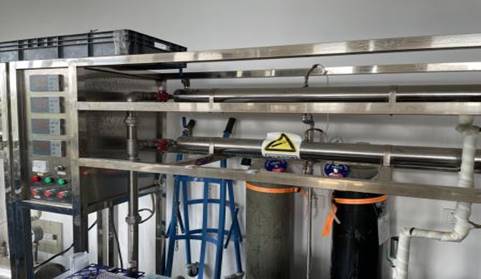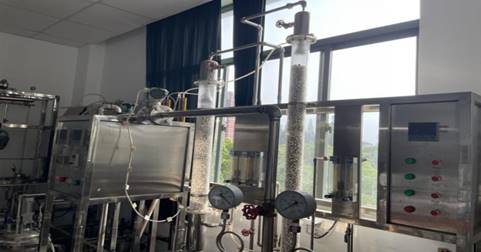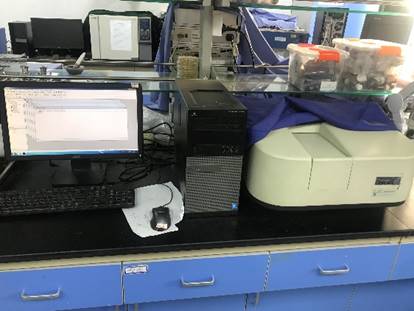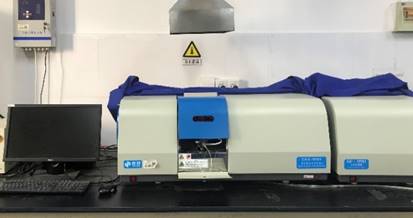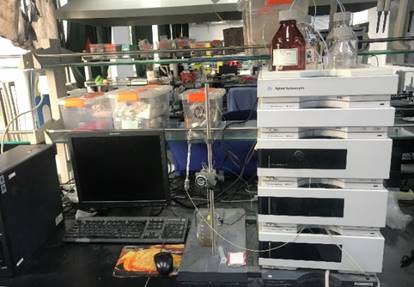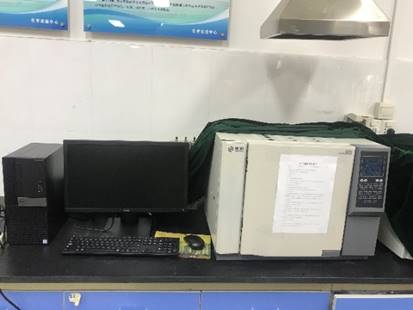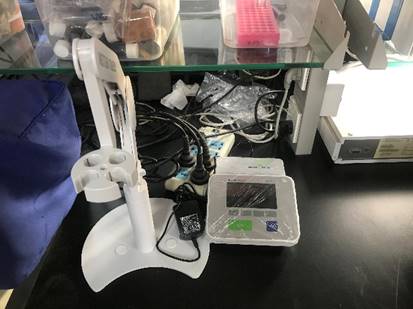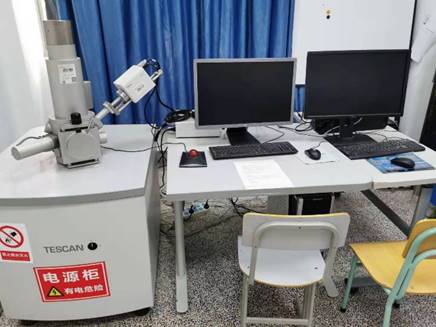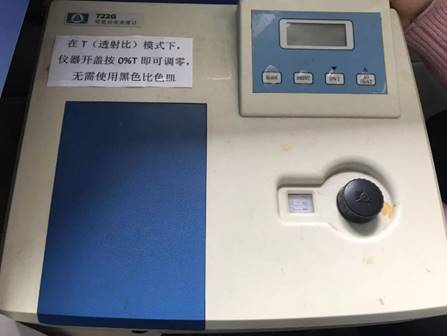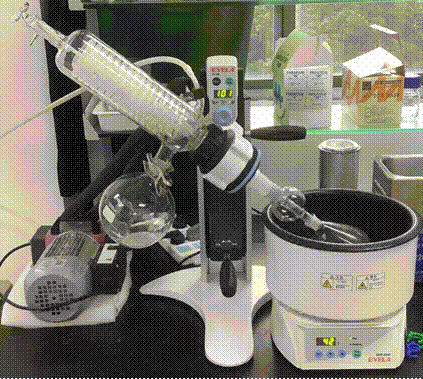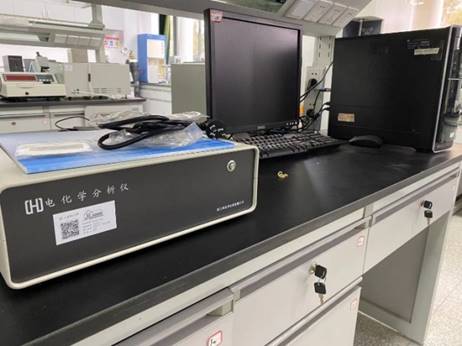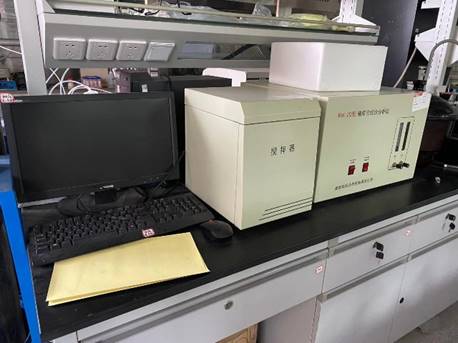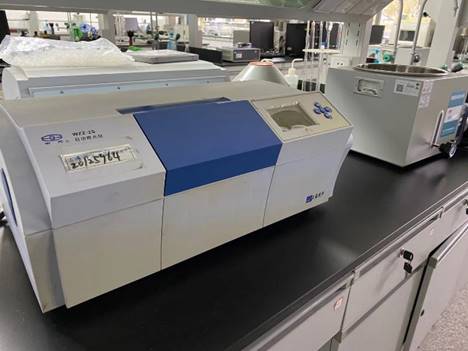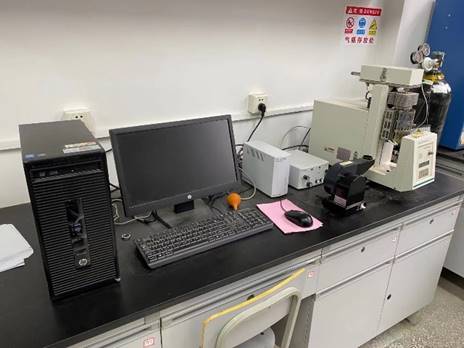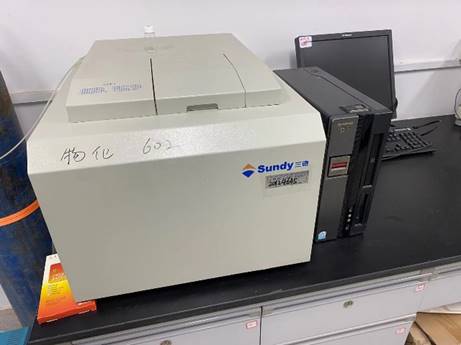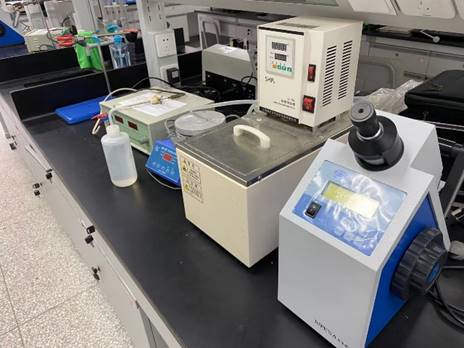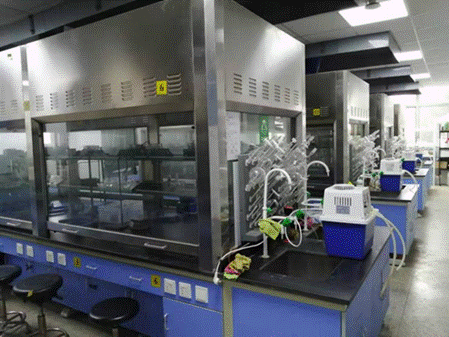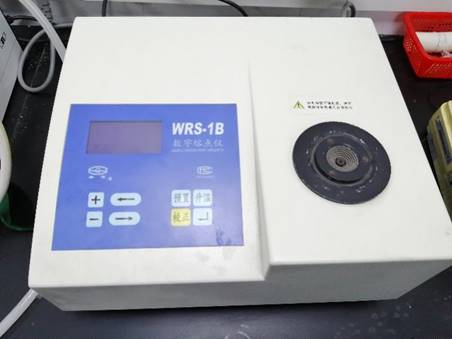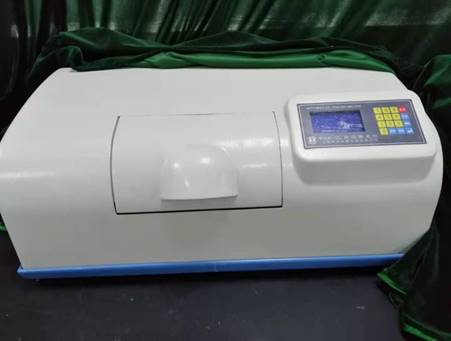1. Introduction of chemistry laboratories for chemical experiments.
Room No. |
Laboratory |
Course |
Room area (m2) |
406 | Chemical Engineering Principle Laboratory | Experiment of Chemical Engineering Principle |
35 |
502 | Analysis Chemistry Laboratory | Analytical Chemistry Experiment |
110 |
503 | Instrumental Analysis Laboratory | Instrumental Analysis Experiment |
85 |
504 | General Chemistry Laboratory | General Chemistry Experiment |
112 |
505 | Inorganic Chemistry Laboratory | Inorganic Chemistry Experiment |
106 |
509 | Comprehensive Laboratory | Comprehensive Experiment |
35 |
601 | Biochemistry Laboratory | Engineering Biochemistry Experiment |
67.2 |
602 | Physical Chemistry Laboratory |
Physical Chemistry Experiment | 120 |
617 | Organic Chemistry Laboratory | Organic Chemistry Experiment | 120
|
Equipment, administrator, opening time and rules for each of the laboratory (listed above)
Room 406 | Chemical Engineering Principle Laboratory |
1. Equipment | Description |
View |
|
Experimental device for determining characteristic curve of centrifugal pump | Familiar with the various pipe fittings and valves that make up the pipeline, understand the temperature, pressure, electric power, flow and other on-site display instruments and sensing detection equipment, and master the measurement principle and use method of the turbine flowmeter. |
Sieve plate tower rectification experiment device | Determine the total theoretical plate number, total plate efficiency and single plate efficiency of the distillation column after stable operation under the condition of total reflux. Determine the number of theoretical plates, total plate efficiency and single plate efficiency of the rectification column after stable operation under a certain reflux ratio. |
Chemical heat transfer comprehensive experimental device | Through the experimental research on the air-steam simple double-pipe heat exchanger, master the method of measuring the convective heat transfer coefficient, and deepen the understanding of its concept and influencing factors |
Experimental device for measuring fluid flow resistance | Learn how to measure the frictional resistance of straight pipes △Pf and the friction coefficient of straight pipes λ; Grasp the relationship between the friction coefficient λ and the Reynolds number Re under different flow rates and the law of change. Verify the relationship between λ and Re in the laminar, transitional, and turbulent regions; Determine the local drag coefficient x when the fluid flows through the valve in a turbulent state; |
Tower gas absorption experiment device | Understand the principle and effect of purifying SO in exhaust gas by absorption method. Change the speed of the empty tower and observe the gas-liquid contact status and flooding phenomenon in the packed tower. Master the method of measuring the absorption efficiency and pressure reduction of the packed absorption tower. |
Decompression reactor | The inner layer can be filled with reaction materials for stirring reaction, and the interlayer can be passed through different cold and heat sources (refrigerant, hot water and hot oil) for cyclic heating or cooling reactions. Under the set constant temperature condition, the sealed glass reactor can carry out constant-rate and constant-rate stirring reaction under normal pressure or negative pressure according to the requirements of use, and can carry out the reflux and distillation of the reaction solution. |
2. Administrator | One Associate Professor and two lab technicians |
3. Opening time | 8:00-17:00 (Monday to Friday) |
4. Main Experiments | ☑ Determining Characteristic Curve of Centrifugal Pump ☑ Sieve plate tower rectification experiment ☑ Chemical heat transfer comprehensive experiment ☑ Measuring fluid flow resistance ☑ Tower gas absorption experiment
|
5. Rules | The laboratory can be used by both teachers and students under the supervision of working staff |
Experimental Science Center Room 502 | Analytic chemistry Laboratory |
1. Equipment | Description |
View | |
4 experiment tables with ventilating system and 3 fume hoods | It was designed for students to conducting experiments safely. |
30 sets of electric heating-jackets | 30 sets of electric heating-jackets to heat the solution in beakers. |
30 sets of glassware toolboxes, burettes and related iron stands | 30 sets of glassware toolbox, burettes and related iron stand for basic experiments. |
8 analytical balances | 8 analytical balances to weigh samples. |
1 oven | 1 oven to dry glassware or metalware. |
1 set of water purification machine | 1 set of water purification machine to provide pure water for experiments. |
2 sets of ultrasonic cleaners | 2 sets of ultrasonic cleaners to clean glassware. |
4 sets of water-cycling pumps | 4 sets of water-cycling pumps to provide vacuum for sucking filtration. |
1 set of ice machine | 1 set of ice machine to provide ice for common cooling purposes |
2. Administrator | One Associate Professor and two lab technicians |
3. Opening time | 8:00-17:00 (Monday to Friday) |
4. Main Experiments | ☑Preparation and concentration comparison of acid and base standard solution ☑Calibration of acid and base standard solution ☑Determination of NaOH and Na2CO3 in mixed alkali sample ☑Determination of molar mass of organic acids ☑Determination of acetic acid in edible vinegar ☑Determination of calcium carbonate in eggshells ☑Additivity test of absorbance ☑The Determination of trace Cr (VI) and Mn (VII) in water at the same time ☑Preparation and calibration of EDTA standard solution ☑Determination of calcium and magnesium ion content and total hardness of water ☑Preparation and calibration of sodium thiosulfate standard solution ☑Determination of glucose content (indirect iodimetry) ☑Determination of iron content by phenanthroline spectrophotometry ☑Determination of sulfur in soluble sulfates |
5. Rules | The laboratory can be used by both teachers and students under the supervision of working staff |
Room 503 | Instrumental Analysis Laboratory |
1. Equipment | Description |
1 set of UV-Vis Spectrophotometer | UV/V spectroscopy is routinely used in analytical chemistry for the quantitative determination of different analytes, such as transition metal ions, highly conjugated organic compounds, and biological macromolecules. Spectroscopic analysis is commonly carried out in solutions but solids and gases may also be studied. 1 set of TU-1901 Double Beam UV-Vis Spectrophotometer. 1 computer.
|
1 set of Electrochemical Workstation | Studies the relationship between electricity; These reactions involve electric charges moving between electrodes and an electrolyte (or ionic species in a solution). 1 Chenhua Electrochemical Workstation. 1 computer.
|
1 set of Atomic Absorption Spectrometer | Atomic absorption spectroscopy (AAS) is a spectroanalytical procedure for the quantitative determination of chemical elements using the absorption of optical radiation (light) by free atoms in the gaseous state. Atomic absorption spectroscopy is based on absorption of light by free metallic ions. 1 set of TAS-990AFG Atomic Absorption Spectrometer. 1 computer.
|
1 set of Liquid Chromatography | Liquid Chromatography is a laboratory technique for the separation of a mixture. Analytical chromatography is done normally with smaller amounts of material and is for establishing the presence or measuring the relative 1 set of Agilent Technologies 1200Series Liquid Chromatography. 1 computer.
|
1 set of Gas Chromstograpgy | Gas chromatograph is an instrument for qualitative and quantitative analysis of multi-component complex mixtures using chromatographic separation and detection techniques. 1 set of PERSEE G5 Gas Chromstograpgy 1 computer
|
1 set of Fluorescence Spectrometer | Fluorescence spectroscopy is a type of electromagnetic spectroscopy that analyzes fluorescence from a sample. It involves using a beam of light, usually ultraviolet light, that excites the electrons in molecules of certain compounds 1 set of RF-5301PC SHIMADZU Fluorescence Spectrometer 1 computer
|
1 set of Fourier Transform Infrared Spectroscopy | Fourier-transform infrared spectroscopy (FTIR) is a technique used to obtain an infrared spectrum of absorption or emission of a solid, liquid or gas. An FTIR spectrometer simultaneously collects high-resolution spectral data over a wide spectral range. 1 set of Thermo NICOLET 380 Fourier Transform Infrared Spectroscopy 1 computer
|
1 set of Ion meter | Ion meter is an electrochemical analytical instrument used to measure ion concentration in solution 1set of METTLER TOLEDO Ion meter 1 computer
|
2. Administrator | Two Associate Professor and two lab technicians |
3. Opening time | 8:00-17:00 (Monday to Friday) |
4. Main Experiments | ☑ Determination of phenol trichlorophenol by dual wavelength ultraviolet spectrum ☑ Electrochemical voltammetry (determination of electrode reaction of potassium ferricyanide) ☑ Determination of iron and copper in soybean milk by atomic absorption spectrometry ☑ Analysis of caffeine in tea cola by liquid chromatography ☑ Determination of alcohol content in wine samples by gas chromatography ☑ Determination of vitamin B2 by fluorescence spectrophotometry ☑ Infrared spectroscopy (KBr tablet method for identification of sodium benzoate) ☑Determination of F- in natural water by ion selective electrode method |
5. Rules | The laboratory can be used by both teachers and students under the supervision of working staff |
Room 504 | Organic Chemistry Laboratory |
1. Equipment | Description |
View |
|
3 experiment tables with ventilating system and 2 fume hoods | It was designed for students to conducting experiments safely. |
SEM:Observe the microscopic morphology of materials |
|
8 electronic balance | To measure the mass of chemicals |
5 thermostat water bath | HH-S6 Thermostat water bath for heating up the chemicals |
pH meter | PHS-3C pH meter for measuring the pH value of solution |
D.C. regulated power supply | QJ3005H D.C. regulated power supply for specific current and voltage |
Ultra-pure water system | UPT-I-10T Ultra-pure water system for deionized water |
Conductivity meter | DDS-307A Conductivity meter for measuring the conductivity of solution |
Spectrophotometer | 722 Spectrophotometer for measuring the absorbance of solution |
Glass apparatus | Common glassware for various purposes like synthesis/extraction/ column chromatography purification/titration/ volumetric weighing etc |
Isothermal magnetic stirrer | 20 DF-101S Isothermal magnetic stirrer for heating and mixing the solution. |
2. Administrator | One senior experimentalist and three experimentalists |
3. Opening time | 8:00-17:00 (Monday to Friday) |
4. Main Experiments | ☑ code of practice and common glassware practice ☑ determination of ionization constant of acetic acid ☑ determination of iron content by absorbance spectrophotometry ☑ galvanizing by electricity ☑ water quality testing ☑ oscillation reaction - iodine-bell reaction
|
5. Rules | The laboratory can be used by both teachers and students under the supervision of working staff |
Room 505 | Inorganic Chemistry Laboratory |
1. Equipment | Description |
View |
|
Central exhaust system | Central exhaust system for air conditioning in the lab |
8 analytical balance | To measure the mass of chemicals
|
Thermostat water bath | HH-S6 Thermostat water bath for heating up the chemicals
|
pH meter | PS-1C pH meter for measuring the pH value of solution
|
Spectrophotometer | 722 Spectrophotometer for measuring the absorbance of solution
|
glass apparatus | Common glassware for various purposes like synthesis/extraction/ column chromatography purification/titration/ volumetric weighing etc |
4 water-cycling pump | 4 pumps to provide vacuum for sucking filtration |
30 sets of Electric Constant temperature heating heating-jackets | Heating sleeves equipped with temperature sensors;
|
2. Administrator | One senior experimentalist and three experimentalists |
3. Opening time | 8:00-17:00 (Monday to Friday) |
4. Main Experiments | ☑ Code of practice and common glassware practice ☑ Determination of the equilibrium constant of acetic acid dissociation ☑ Determination of chemical equilibrium constants by absorbance spectrophotometry ☑ galvanizing by electricity ☑ water quality testing ☑ oscillation reaction - iodine-bell reaction ☑ Anionic cation identification ☑ Preparation of ammonium ferrous sulfate ☑ Preparation of Hexaamminecobalt(III) chloride ☑ Preparation of copper sulfate and determination of crystal water ☑ Preparation of potassium trioxalate and ferrite ☑ The burning iron |
5. Rules | The laboratory can be used by both teachers and students under the supervision of working staff |
Experimental Science Center Room 509 | Comprehensive Chemistry Laboratory |
1. Equipment | Description |
View | |
2 fume hoods for conducting experimental organic chemistry | Each fume hood (170 *75 *80 cm) was designed for one student to conducting organic chemistry experiments safely and independently |
6 heating stirrer, glassware toolbox and related iron stand
| 6 heating stirrers equipped with temperature sensors; Common glassware for various purposes like synthesis/extraction/ column chromatography purification/titration/ volumetric weighing etc. |
2 Oven and thermostat water bath | 2 ovens to dry glassware, 1 thermostat water bath to heat liquids. |
1 tripurpose ultraviolet analyzer
| 1 tripurpose ultraviolet analyzer for checking the quality of hormone alkaloids, vitamins and other drugs that can produce fluorescence. |
1 roto evaporator | 1 roto evaporator for removing solvents from the mixture
|
1 water-cycling pump | 1 pump to provide vacuum for sucking filtration |
1 henghui DC power supply | 1 DC power supply station for testing the stability of synthesized materials. |
1 electrochemical station | 1 electrochemical station and 1 xenon lamp steady current supply for testing the electrochemical performances such as LSV, CV, EIS and so on.
|
2. Administrator
| One Associate Professor and two lab technicians |
3. Opening time | 8:00-17:00 (Monday to Friday) |
4. Main Experiments | ☑ Laboratory safety education ☑ Preparation of pearlescent Shampoo ☑ Preparation of polyurethane foam plastics ☑ Preparation of sunscreen and determination of sunscreen index ☑ Hydrothermal synthesis of titanium dioxide ☑ Extraction of caffeine from tea
|
5. Rules | The laboratory can be used by both teachers and students under the supervision of working staff |
Room 601 | Biochemistry Laboratory |
1. Equipment | Description |
1 set of fume hood | 1 set of fume hood was designed for safely solution preparation and organic chemistry experiments |
20 sets of intelligent digital display multifunctional oil bath pot |
Heating stirrers equipped with temperature sensors;
|
2 ovens | 1 common oven to dry samples or glassware 1 vacuum oven to dry samples containing a small amount of water under vacuum conditions |
1set of water-cycling pump | 1set of pump to provide vacuum for sucking filtration |
1set of ultrapure water machine | Used for preparing distilled water and deionized water |
1 set of water molecular titrator | Rapid determination of moisture content in samples |
pH/conductivity meter | The conductivity or pH of a rapid liquid sample |
20 alcohol lamps | 20 alcohol lamps |
2. Administrator | Two lecturers |
3. Opening time | 8:00-17:00 (Monday to Friday) |
4. Main Experiments | ☑ The separation of amino acids by plate chromatography ☑ The determination of amylase activity ☑ Protein content was determined by coomassie bright blue G-250 method ☑ The preparation of culture medium ☑ Soil dilution, separation, purification and aseptic operation techniques. ☑ The simple staining of bacteria and gram staining ☑ The usage of microscopes and the observation of microbial specimens
|
5. Rules | The laboratory can be used by both teachers and students under the supervision of working staff |
Room 602 | Physical Chemistry Laboratory |
1. Equipment | Description |
1 set of electrochemical analyzer | Used for the measurement of electrochemical data, including: 1 electrochemical workstation 1 computer 1 set of electrodes including platinum electrode, calomel electrode, glassy carbon electrode
|
1 set of microcoulomb comprehensive analyzer | Used for the analysis of sulfur, chlorine, nitrogen in samples, including 1 computer 1 set of microcoulomb comprehensive analyzer |
1 set of automatic polarimeter | Use for measuring the rotation of materials. The measurement results can be automatically converted by PC, and the concentration, content and purity of the samples can be analyzed.
|
1 set of thermogravimetric analyzer | Use for measuring the relationship between temperature and mass change, including: 1 computer 1 set of thermogravimetric analyzer
|
1 set of Brunauer-Emmett-Teller | Used for measuring specific surface area of materials, including 3 roto evaporators for removing solvents from the mixture 1 computer
|
1 set of heat of combustion analyzer | Used for measuring the heat of combustion, including 1 set of heat of combustion analyzer 1 computer |
1 set of digital abbe refractometer | It is an analytical instrument used to measure the refractive index in the field of biology.
|
2. Administrator | Two Professor and one lab technicians
|
3. Opening time | 8:00-17:00 (Monday to Friday) |
4. Main Experiments | ☑ Determination of the gross heat of combustion ☑ Thermogravimetric analysis ☑ The measurement of specific surface area ☑ The phase diagram of completely mutually soluble two-liquid system ☑ The equilibrium constant of liquid phase reaction ☑ Determination of partial molar volume of solution ☑ Determination of electromotive force and its application ☑ Conversion of sucrose ☑ Saponification reaction of ethyl acetate ☑ Determination of surface tension of solution ☑ The control of temperature ☑ Determination of solution viscosity |
5. Rules | The laboratory can be used by both teachers and students under the supervision of working staff |
Room 617 | Organic Chemistry Laboratory |
1. Equipment | Description |
View |
|
20 fume hoods for conducting experimental organic chemistry | Each fume hood (170 *75 *80 cm) was designed for one student to conducting organic chemistry experiments safely and independently |
40 heating stirrer, glassware toolbox and related iron stand
| 40 heating stirrers equipped with temperature sensors; Common glassware for various purposes like synthesis/extraction/ column chromatography purification/titration/ volumetric weighing etc |
1 Oven | To dry glassware,metalware when needed |
3 roto evaporators | 3 roto evaporators for removing solvents from the mixture
|
10 water-cycling pumps | 10 pumps to provide vacuum for sucking filtration |
1 ice machine | 1 set of ice machine to preparation of ice for common cooling purposes |
3 sets of recirculating chillers | 3 sets of recirculating chillers to provide low temperature (-78 °C) for some synthetic reactions or other special purposes |
Digital melting-point apparatus | Type WRS-1B for the determination of melting points of organic compound
|
Automatic Polarimeter | WZZ-2S Automatic Polarimeter for determination of enantiopure organic compounds
|
2. Administrator | One Associate Professor and two lab technicians
|
3. Opening time | 8:00-17:00 (Monday to Friday) |
4. Main Experiments | ☑ Asprin Synthesis ☑ Recrystallization of benzoic acid ☑ Synthesis of 2-chlorobutane ☑ Purification by column chromatography ☑ Resolution of α-phenylethylamine ☑ Extraction of caffeine from tea ☑ Synthesis of sulfonamide antibiotics ☑ Synthesis of ethyl benzoate ☑Synthesis of 3-methyl acetophenone |
5. Rules | The laboratory can be used by both teachers and students under the supervision of working staff |





